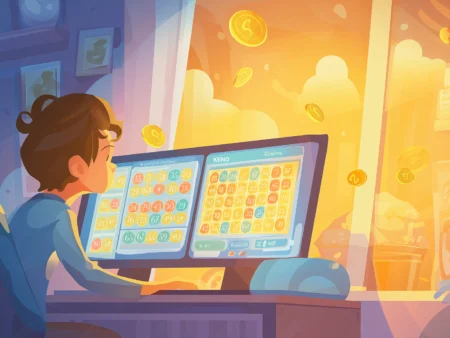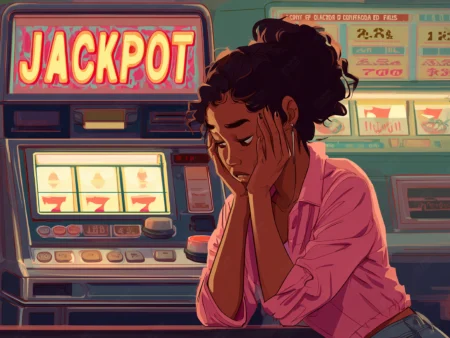Ever opened with AQ offsuit from early position and instantly regretted it after a 3-bet? Or maybe you’ve folded 99 in the hijack, only to watch a harmless flop roll out while someone else scoops the pot. That sting doesn’t come from bad luck, it comes from not having a plan.
That’s exactly what preflop charts are made for.
Most leaks in poker don’t show up on the river, they start before the flop. A bad preflop decision forces you into marginal spots, awkward postflop spots, and stack-draining lines you didn’t want to be in.
Whether you’re multi-tabling 6-max cash or deep in a Sunday MTT, having structured preflop ranges built into your process changes everything. These charts give you the edge: when to raise, when to fold, when to press back, and when to just stay out of the damn way.
In this guide, we’ll break down how real grinders use preflop charts, based on position, hand strength, and table dynamics, plus give you downloadable tools you can plug into your game right away.
We’re not here to quote solvers for the sake of it. You’ll get real-world strategy, player-tested insights, and a chart that actually helps you win more pots.
Table of contents
- What Are Preflop Charts (and Why You Should Actually Use Them)
- The Core Elements of a Preflop Decision
- Downloadable Preflop Charts for Common Scenarios
- How to Read a Poker Preflop Chart Like a Pro
- When to Raise, Fold or Call (Real Preflop Scenarios)
- Do You Really Need to Memorize Preflop Charts?
- FAQ: Preflop Strategy Questions Players Actually Ask
- Final Take: Your Preflop Edge Starts with Structure, Not Luck
What Are Preflop Charts (and Why You Should Actually Use Them)
A preflop chart is your roadmap, a visual cheat sheet that tells you exactly which hands to raise, call, or fold from each position at the table. Think of it as a refined version of all possible Texas Hold’em starting hands, trimmed to the most profitable actions based on math, position, and long-term EV.
These charts aren’t guesswork. They’re built using a blend of:
- GTO solvers like PioSolver or MonkerSolver
- Hand equity calculations across thousands of simulations
- Real-world data on opponent tendencies and outcomes
The result? Charts that don’t just suggest what could work, they reflect what actually wins over time.For example, a standard 6-max cash game preflop chart might recommend opening KTs from the cutoff, but folding that same hand UTG.
It’s not about preference, it’s about equity, position, and expected value.
Two Key Approaches to Preflop Charts
1. GTO-Based Ranges
These are balanced, unexploitable strategies designed to hold up against any opponent. A GTO chart might suggest mixing frequencies (raise KQo 70%, fold 30%), but for practical use, most charts simplify this into clear, consistent actions.
They form the baseline of modern poker ranges.
2. Exploitative Ranges
Built to crush specific player types. Playing live $1/$2 with three limp-callers? You can open wider and lean on position to punish them. Exploitative ranges bend the GTO blueprint when you recognize where your opponents are bleeding chips.
Why Use a Chart at All?
Because most bad decisions happen before the flop.
A consistent preflop strategy:
- Saves mental energy
- Eliminates costly second-guessing
- Keeps you out of marginal, tough-to-play spots
- Sets you up to maximize value post-flop, where the real edge lives
And if you’re already diving into GTO charts or building out custom ranges, having a visual structure means fewer mistakes, less tilt, and more clarity in-game.
The Core Elements of a Preflop Decision
Preflop strategy isn’t just about hand strength, it’s about context.
That same KJo that’s a slam-dunk raise on the button becomes a costly mistake under the gun. If you’re not factoring in position, hand class, stack depth, and player types, you’re not just playing, you’re guessing.
Let’s break down the key variables that shape sharp, profitable preflop play.
Position Matters More Than You Think
If you’re looking at your hole cards without considering where you’re seated, you’re leaving money on the felt, full stop.
In Texas Hold’em, position dictates how much information you’ll have before you act. The earlier your seat, the more players behind you, and the less room for marginal hands.
Here’s a quick breakdown of positions at a standard 6-max table:
- UTG (Under the Gun): First to act. Tightest range.
- HJ (Hijack): Slightly looser, but still early.
- CO (Cutoff): Second-best seat, opens widen.
- BTN (Button): Best position. Open wide, steal often.
- SB (Small Blind): Toughest postflop spot. Play tight and strategic.
- BB (Big Blind): Last to act preflop, but OOP postflop. Defend carefully.
Why it matters: Take a hand like KJo. From the button, it’s an easy open. From UTG, it’s a leak.
The difference? Positional leverage. And a lot of players don’t lose because they play bad hands, they lose because they play decent hands in bad spots.
Hand Strength Isn’t Always Enough
AJo looks great, until it doesn’t.
You open AJo from early position, get called by the button, and the flop brings an ace. Now you’re out of position, getting value-owned by AQ, AK, or worse, a sneaky flatted pair.
Meanwhile, KTs, a hand most beginners dismiss, plays beautifully from the cutoff or button, it’s suited, connected, and tough to dominate.
This is the trap of so-called “playable” hands.
They feel too strong to fold… but rarely return value unless used in the right context.
Preflop charts eliminate this emotional noise.
They force you to rely on math, structure, and long-term EV, even if that means folding a hand you “like.”
Stack Depth, Opponent Type, and Table Dynamics
No chart exists in a vacuum. Your ranges must flex with the game.
In tournaments:
- Short stacks (under 20BB): You’re in push/fold territory.
- Mid stacks (40BB–60BB): Start incorporating 3-bet/fold logic.
- Deep stacks (100BB+): More room to play suited connectors, trap with premiums, and adjust to ICM.
For example:
- 66 on a 15BB stack (CO)? Likely a shove.
- 66 with 100BB in a cash game? Raise or fold to aggression.
Table dynamics matter, too:
- If the Big Blind is a nit, open wider from late position.
- If the Button has high VPIP / low PFR, shift to value-heavy opens.
- Facing aggro 3-bettors? Tighten your RFI range and trap them.
Using a HUD?
- Pay attention to VPIP, PFR, 3-bet%
- Exploit tendencies early and often
Not using one? Just watch, patterns reveal themselves quickly, especially online.
Preflop charts give you the baseline, but real edges come from real-time adjustments. That’s how you go from “playing solid ranges” to actually dominating soft tables.
Downloadable Preflop Charts for Common Scenarios
You don’t need to memorize thousands of preflop combos. You need structure, and that’s exactly what these charts deliver.
We’ve built a set of free, downloadable poker preflop charts covering the most common poker formats: cash games, tournaments, 6-max, and full ring. These charts are grounded in GTO fundamentals, but cleaned up for real play. No solver jargon. No mental gymnastics. Just actionable, position-based guidance for your next session.
Cash Game Preflop Chart (100BB Effective)
Perfect for online or live cash games where stacks are deep and ranges are dynamic. This chart assumes standard rake and typical low-to-mid stakes player pools, though you can tighten it up for tougher games.
6-Max Cash Game – RFI Chart – UTG (100BB)
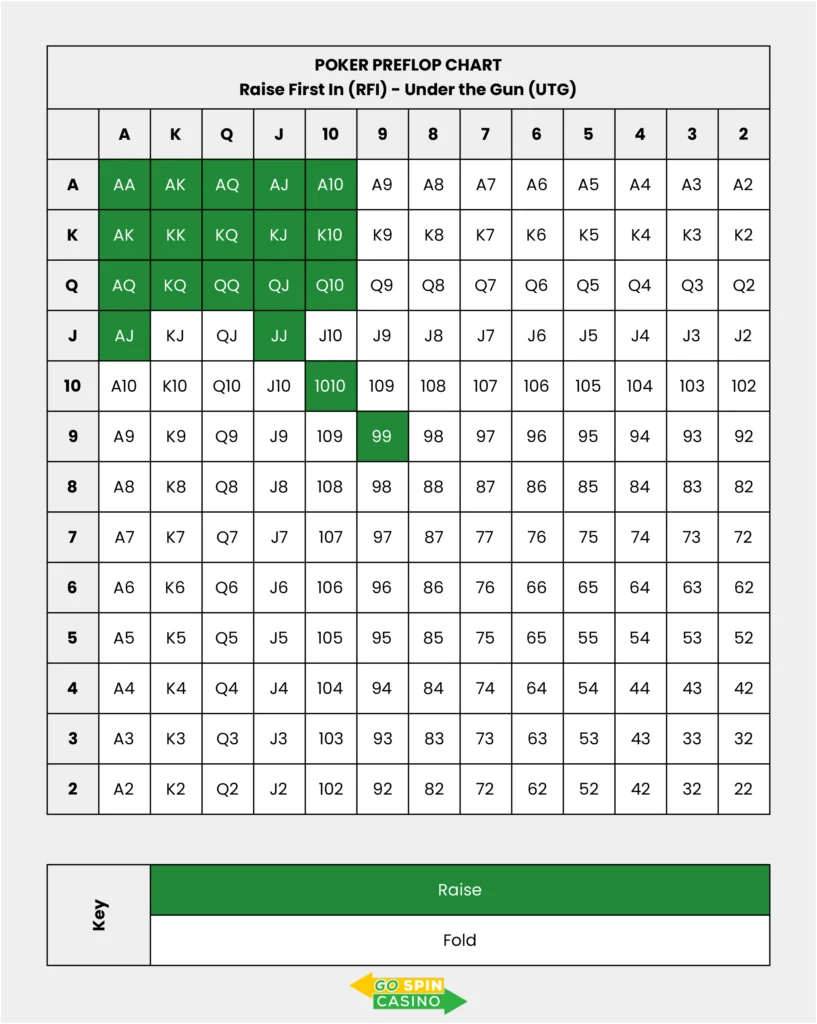
This is your tightest preflop RFI range, optimized for UTG in 6-max. As you move to HJ, CO, BTN, ranges open up.
6-Max Cash Game – RFI Chart – Hijack (HJ)
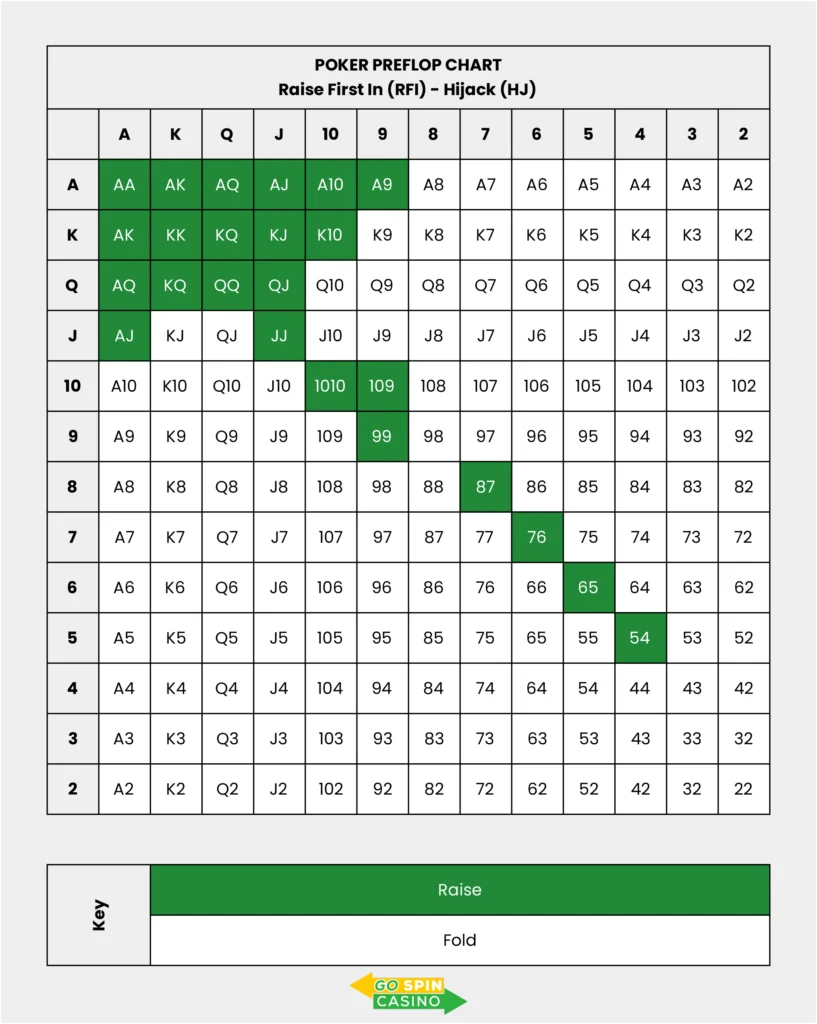
You’ll notice slightly more suited aces, suited connectors, and offsuit broadways are added here compared to UTG — but still a disciplined range.
6-Max Cash Game – RFI Chart – Cutoff (CO)
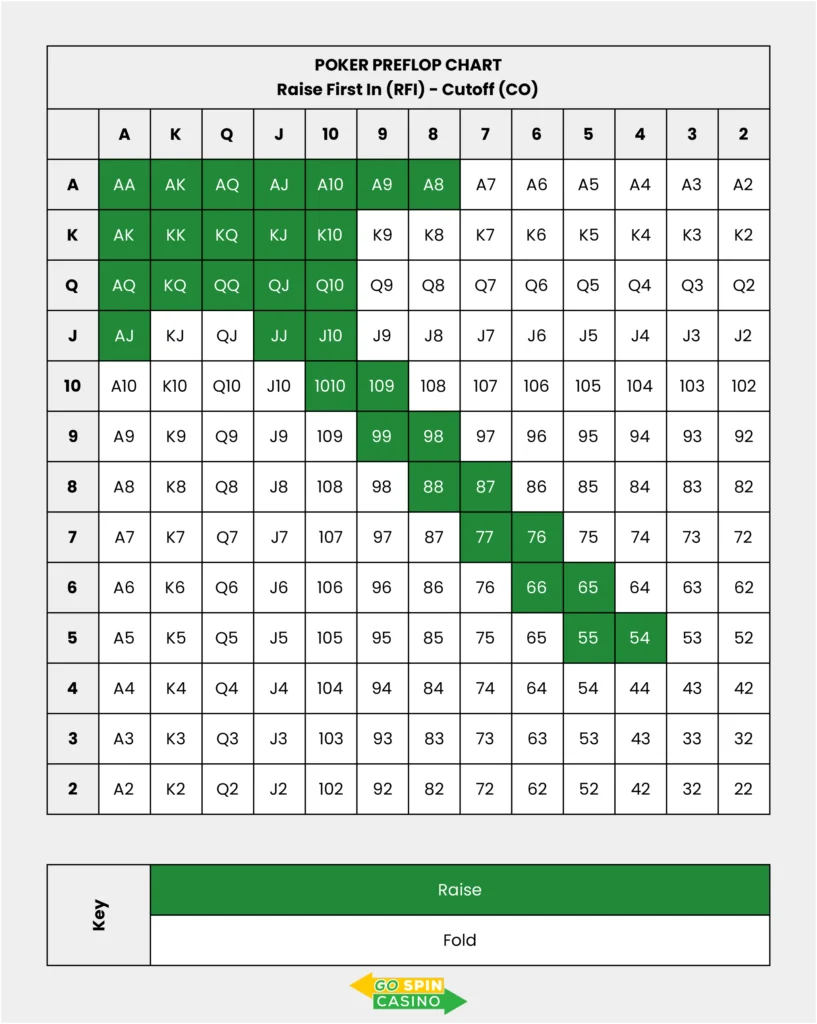
Compared to HJ, the CO adds more suited aces (A8s+), low suited connectors (65s, 54s), and opens wider suited broadways. It’s a good balance of value and pressure.
6-Max Cash Game – RFI Chart – Button (BTN)
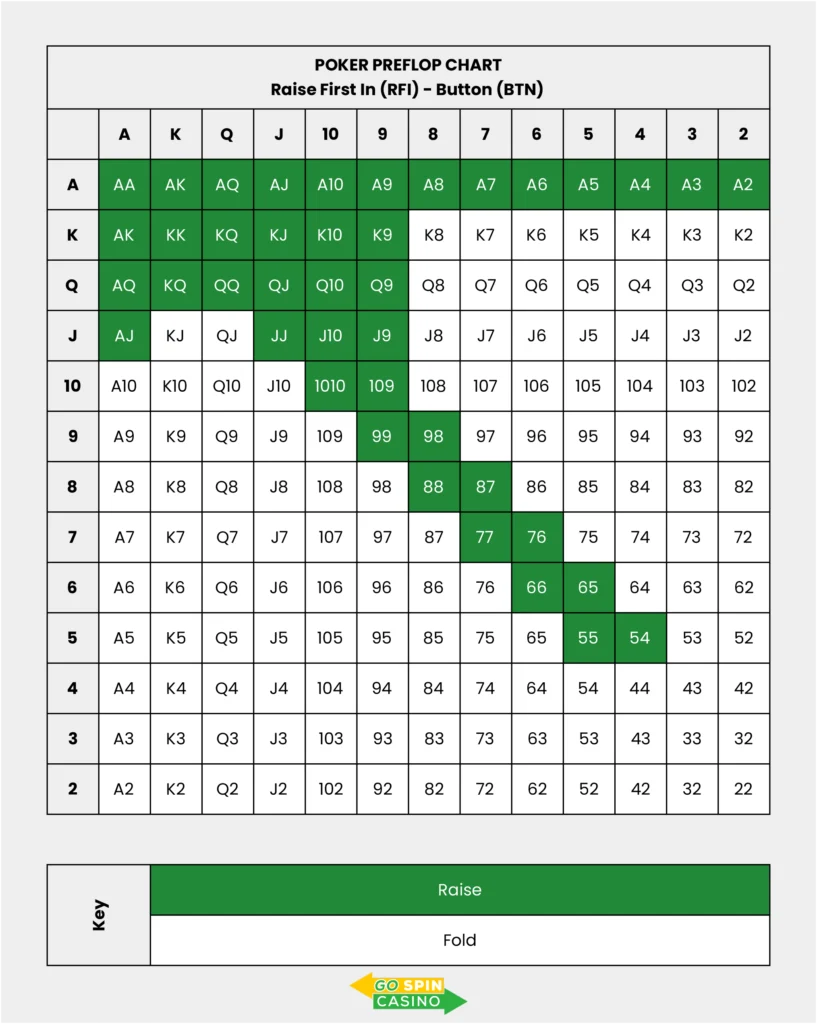
On the Button, you’re raising over 45% of all hands — including any suited ace, suited kings (K8s+), low pocket pairs, and connected hands down to 65s. You’re leveraging position and fold equity.
6-Max Cash Game – RFI Chart – Small Blind (SB)
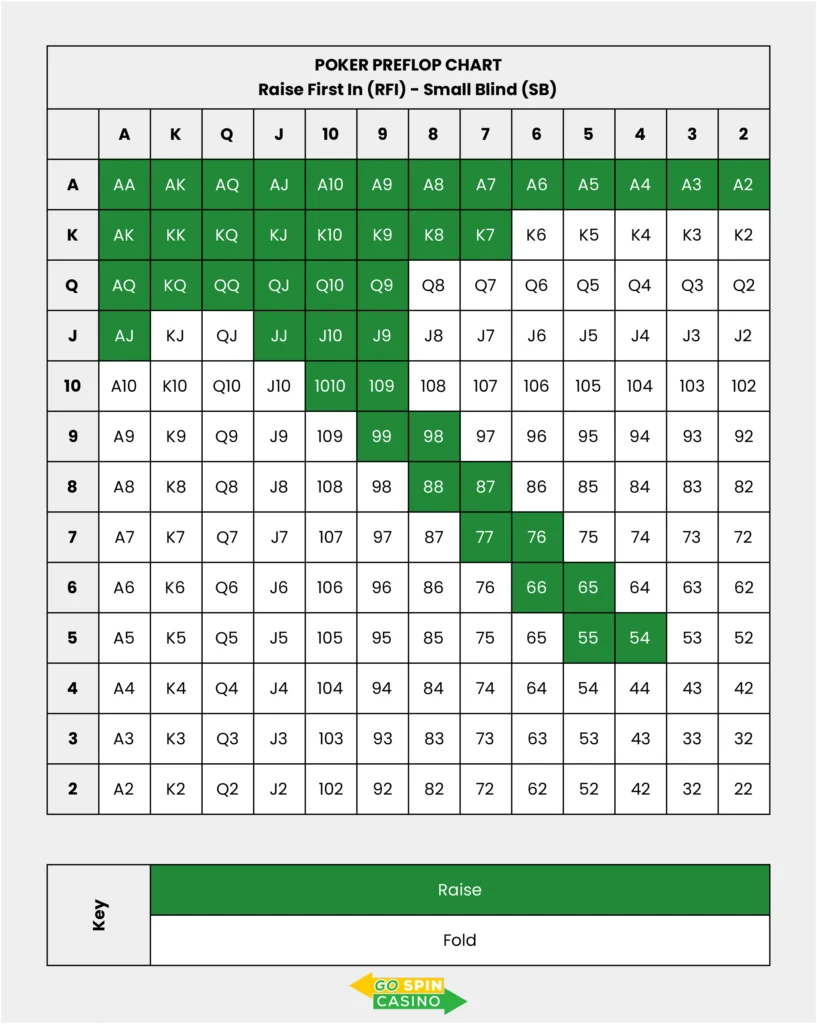
SB RFI is tight but linear — focused on equity and playability from out of position. No limping here. Just clean, fold equity-driven openings with hands that don’t crumble postflop.
Tournament Preflop Chart
Tournament play is all about stack size, and these charts help you avoid mistakes that cost chips (or your tournament life).
MTT Push/Fold Chart – 10BB – Button (6-Max)
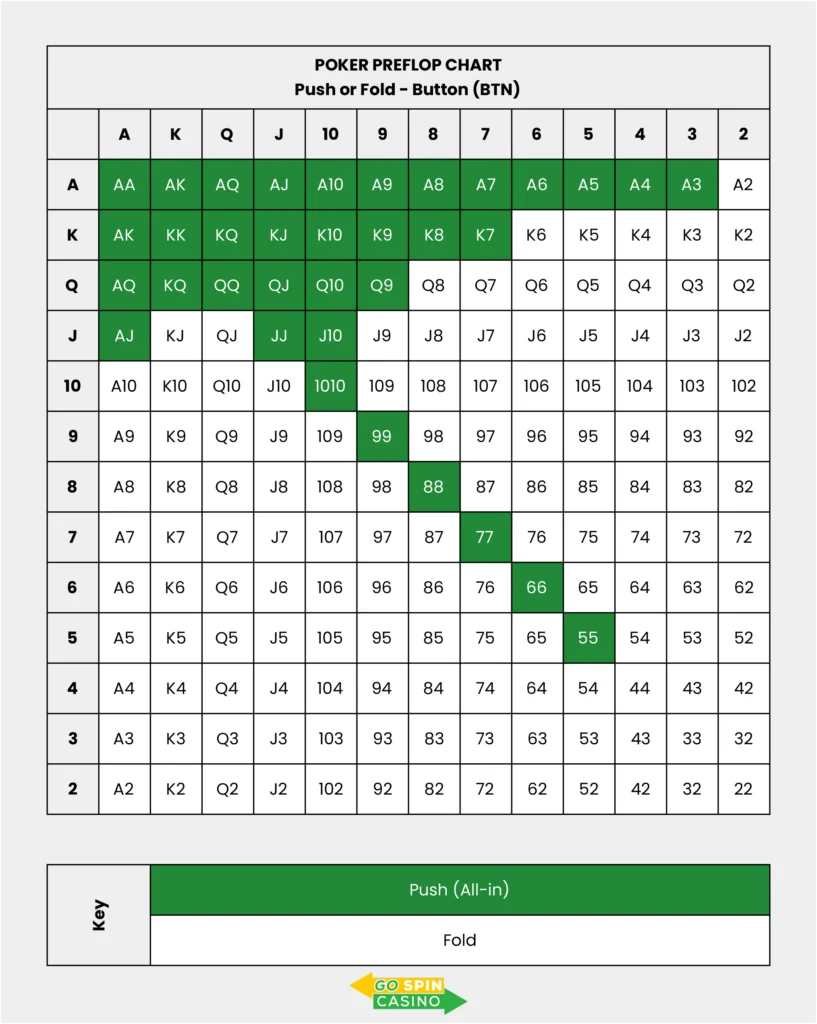
This chart maximizes fold equity from the Button — you’re pushing around 40–45% of hands. Includes all suited aces, strong suited kings, medium pocket pairs, and select suited connectors with high equity realization.
MTT Push/Fold Chart – 10BB – Cutoff (CO, 6-Max)
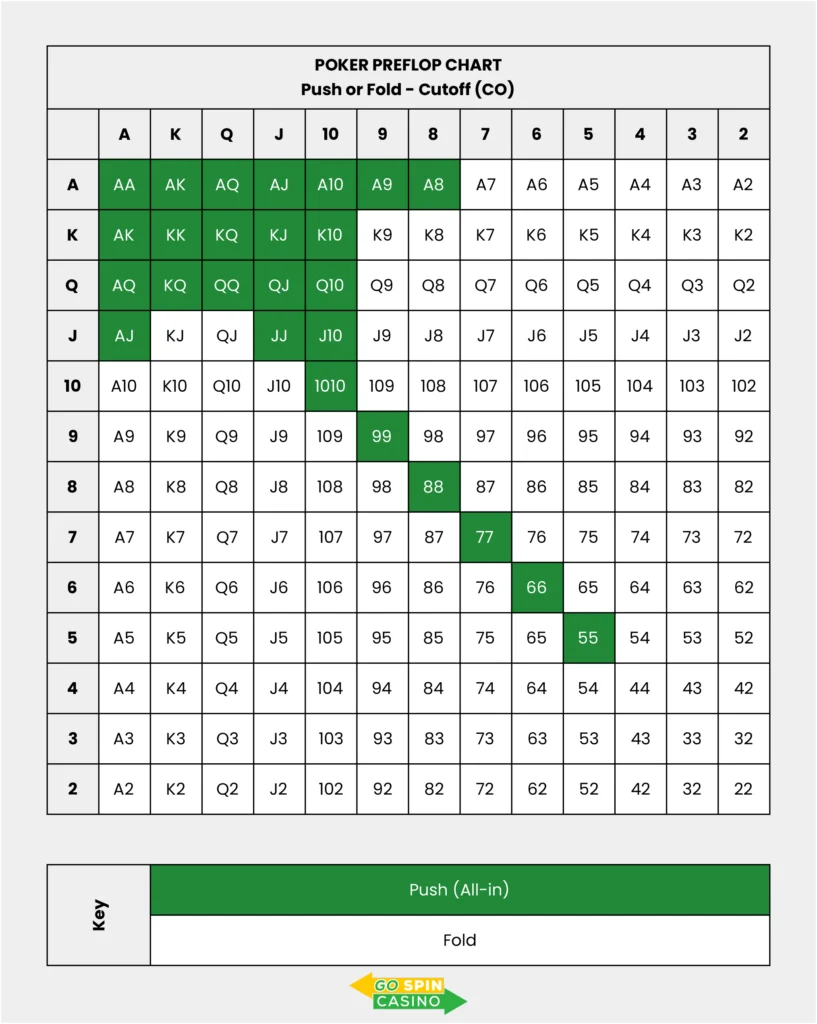
From the Cutoff, you’re jamming a bit tighter than the Button — closer to 30–35% of hands, focused on suited aces, top pairs, and select suited connectors.
MTT Push/Fold Chart – 10BB – Hijack (HJ, 6-Max)
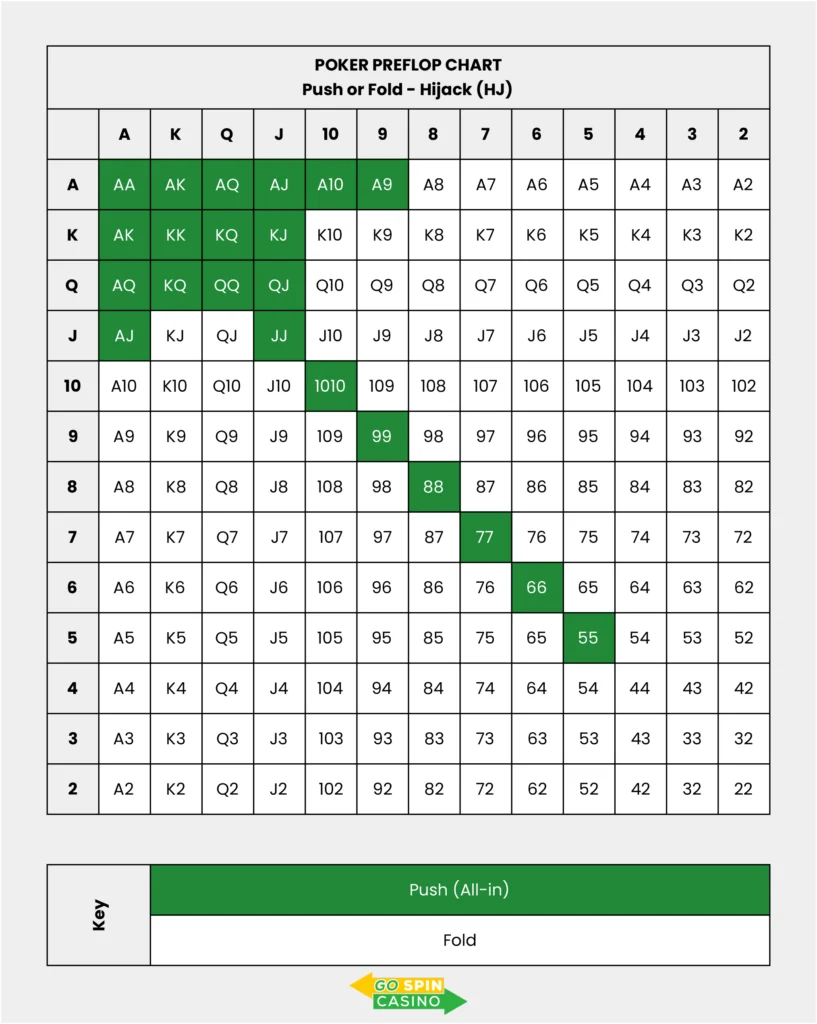
From HJ, you’re pushing a tighter range — about 18–22% of hands. Focus stays on high-card equity, suited broadways, and pairs 55+. Most suited connectors and lower suited aces drop off.
MTT Push/Fold Chart – 10BB – UTG (6-Max)
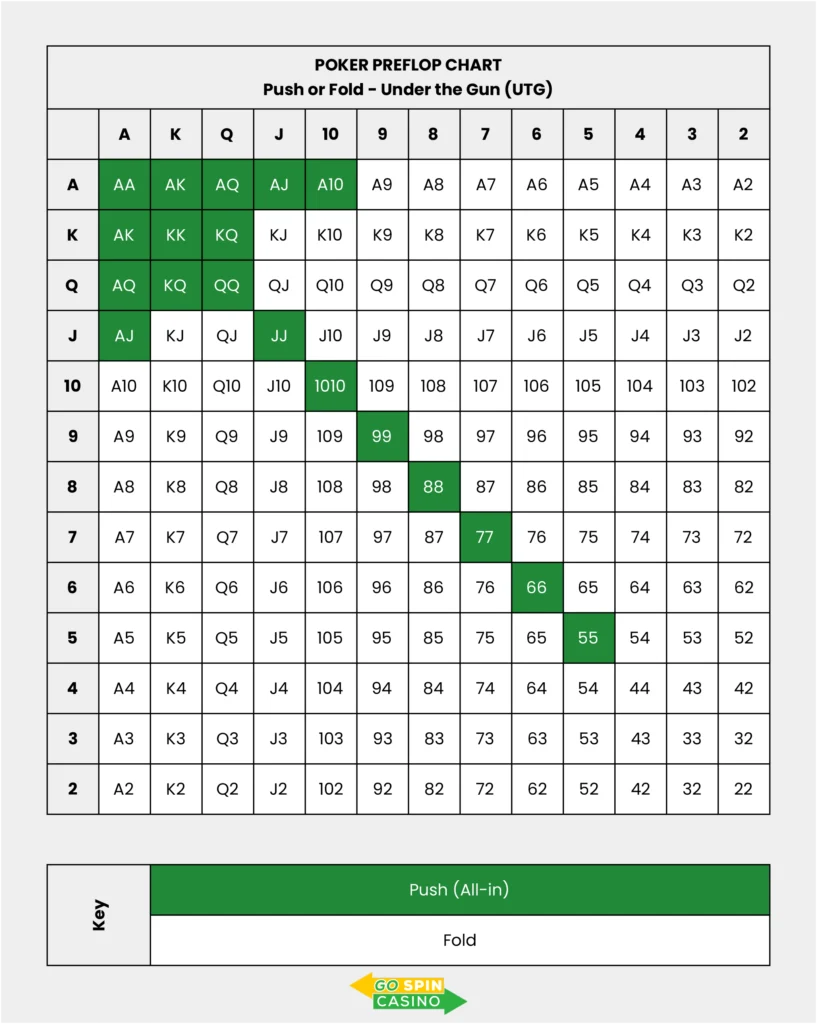
This is the tightest push range of the 10BB set — roughly 13–15% of hands, emphasizing strong suited aces, broadways, and pairs 55+. Every chip matters at this stack depth and position.
Big Blind Defense
This chart shows which hands you should defend (call) from the Big Blind vs a Button open, assuming no ante pressure and no ICM implications. This is where postflop playability matters most — suited, connected, or blocker-heavy hands get prioritized.
Big Blind Defense Chart – 20BB – vs Cutoff Open (6-Max)
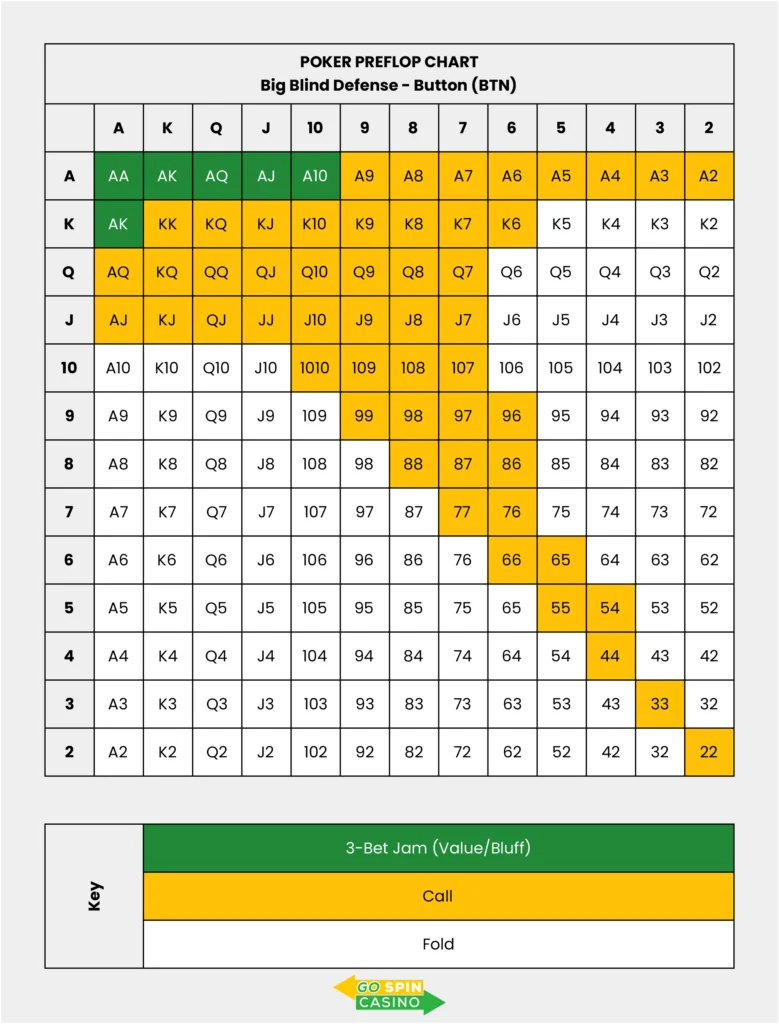
Compared to BB vs BTN opens, you’re defending closer to 40–45% of hands here.
Focus is on:
- All broadway suiteds
- Top pairs (55+)
- Suited aces A8s+
- Playable connected hands
Big Blind Defense Chart – 20BB – vs Hijack Open (6-Max)
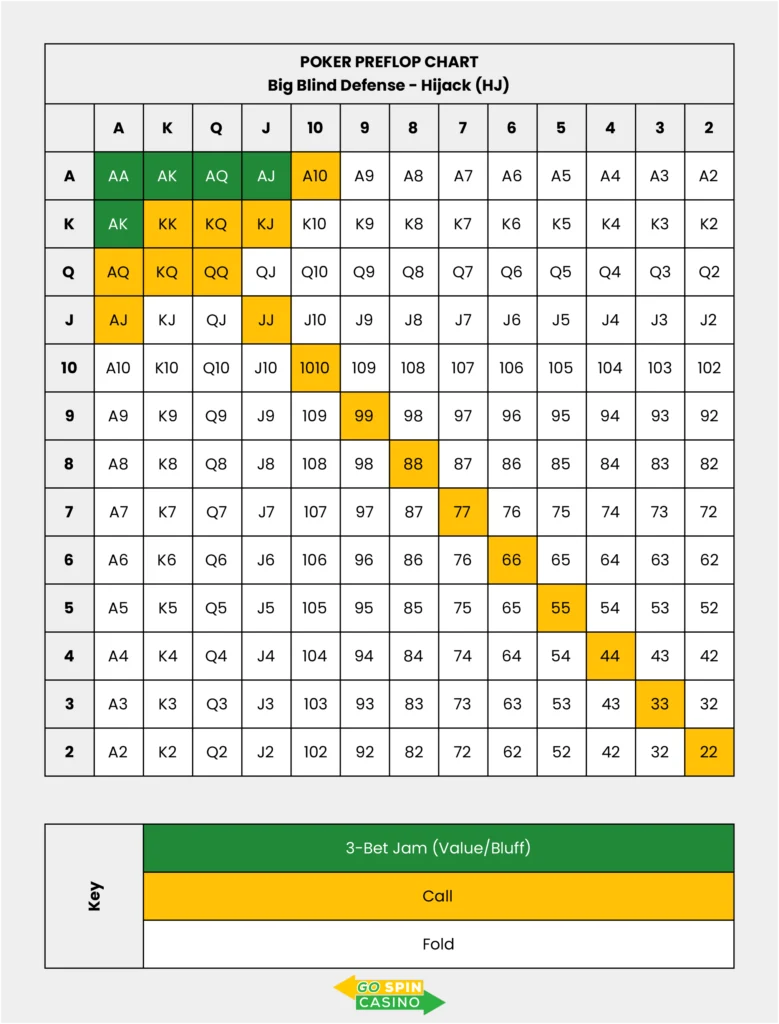
You’re defending around 30–35% of hands. Strategy focuses on:
- Equity-driven flats (suited aces AJs+/ATs, broadways)
- Medium pairs with set mining potential
- No marginal offsuits or weak connectors from this range
Big Blind Defense Chart – 20BB – vs UTG Open (6-Max)
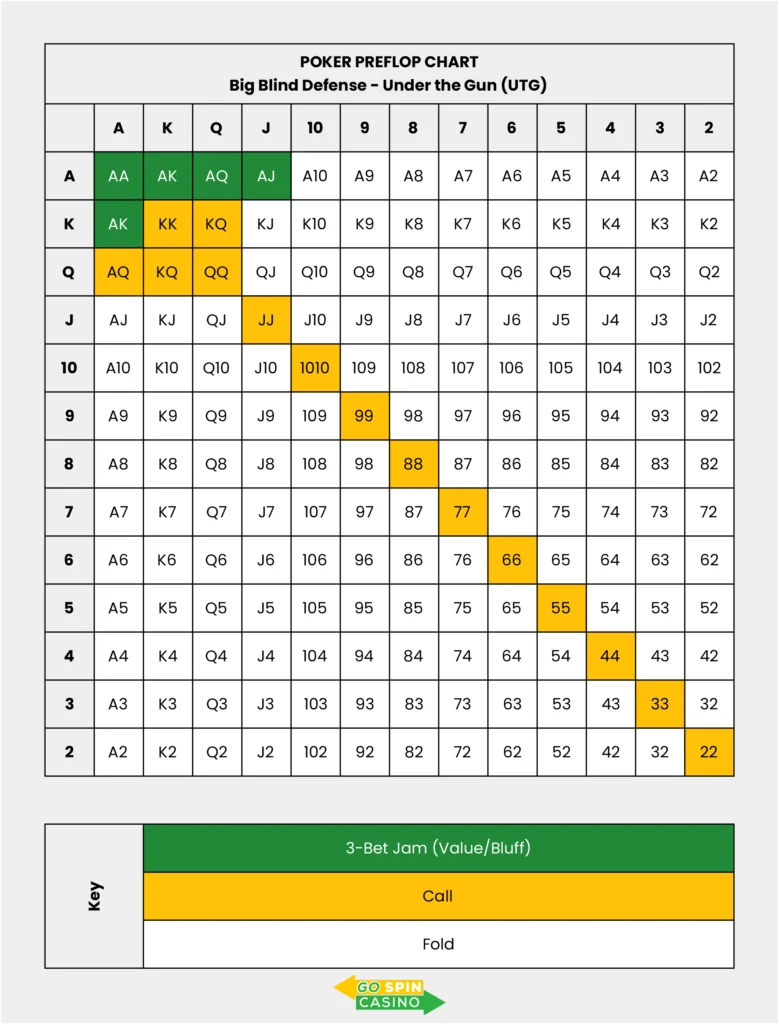
You’re defending only around 25–28% of hands here — focusing on:
- Strong broadway hands
- Pocket pairs 55+
- Playable suited aces and connectors with high equity realization
Call vs Open
This is one of the most common spots in tournaments. At 20BB, you’re in a stack depth where flatting is still viable on the button, but only with select hands that play well postflop and don’t get you dominated.
Call vs Open Chart – BTN vs CO – 20BB (6-Max)
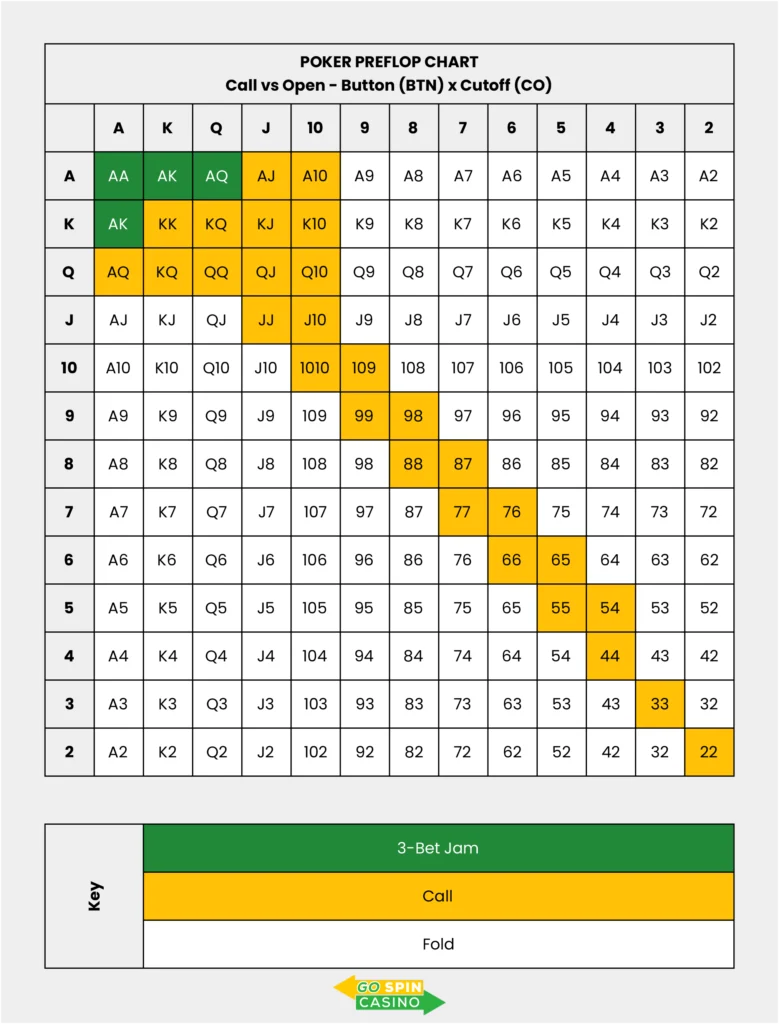
At 20BB BTN vs CO, you’re flatting ~15–20%:
- Broadway suiteds (KQs, QJs, JTs)
- Mid-high pocket pairs (22–99)
- Suited connectors 65s+ in soft fields
- You’ll 3-bet jam premiums and fold dominated offsuit combos
Call vs Open Chart – CO vs HJ – 20BB (6-Max)
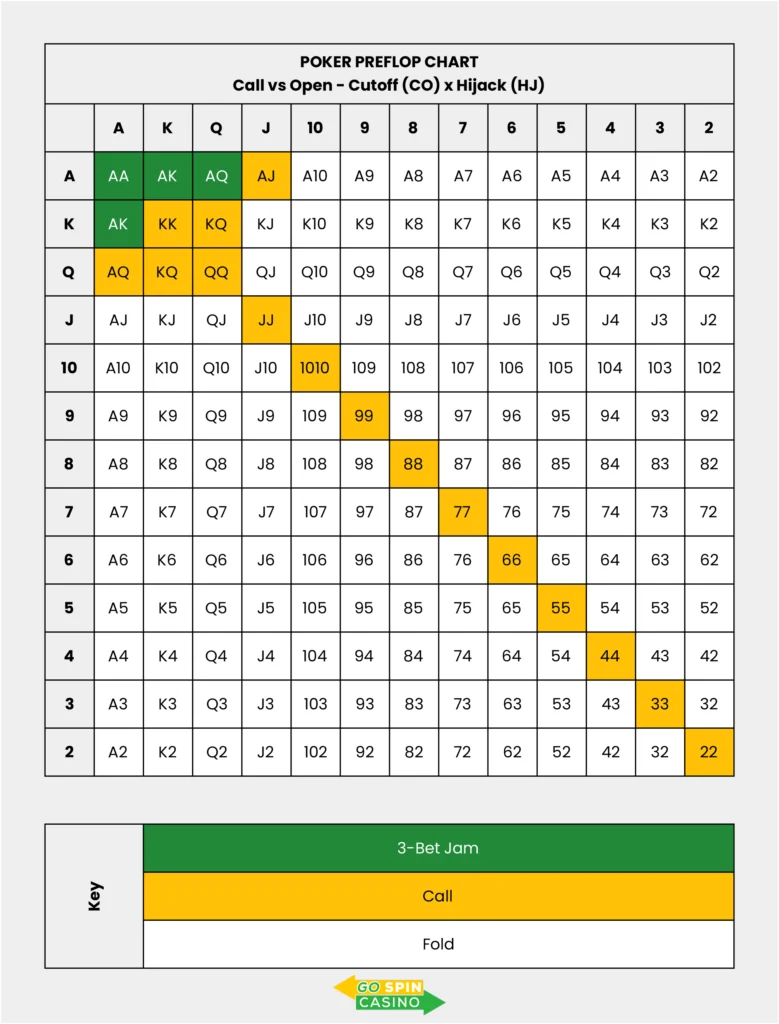
Key takeaways CO vs HJ at 20BB:
- Tight flatting range (~10–15%)
- Prioritize suited broadways and pocket pairs
- Jam with premiums (AA–QQ, AKs) and mix bluff 3-bets with blockers (like A5s, KJs in exploitative spots)
Call vs Open Chart – SB vs BTN – 20BB (6-Max)
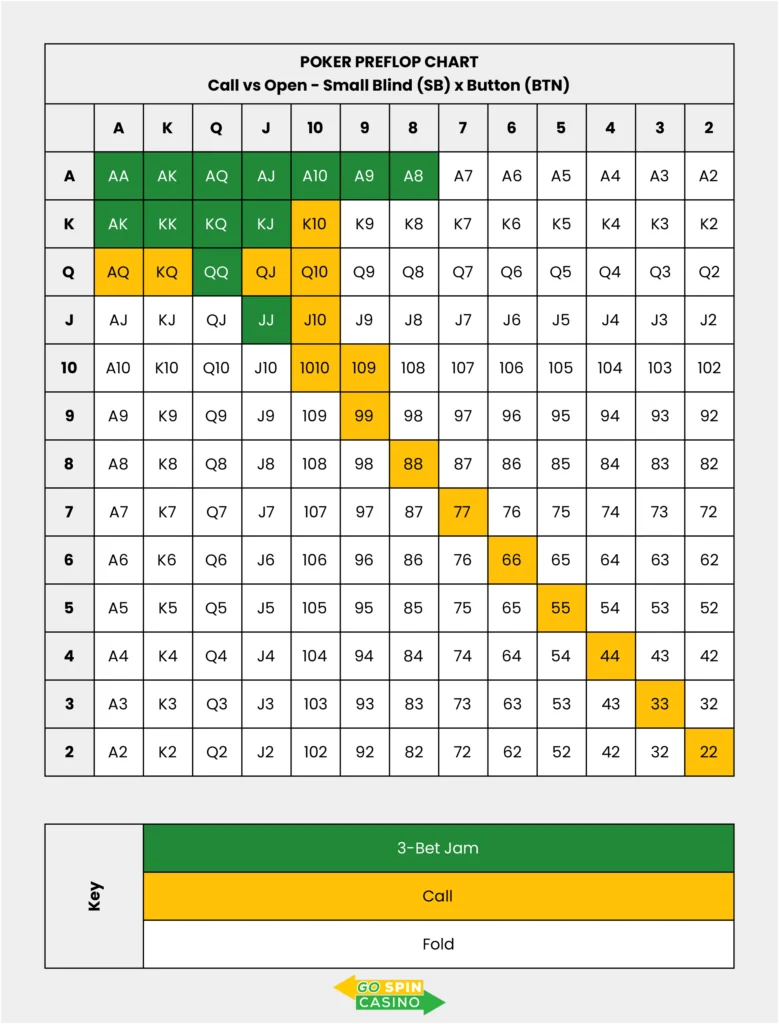
Key points SB vs BTN at 20BB:
- Strategy is mostly 3-bet shove or fold
- Flat only with hands that dominate villain’s range and have great postflop playability
- 3-bet jam includes all premiums, strong suited aces, high equity hands, and some A5s / KTs type blockers
3-Bet Ranges
This is a key spot for balanced aggression. At this stack depth, your BTN range should include:
- Value jams with strong premiums
- Bluff 3-bets with suited blockers and high equity hands
- Flats with hands that play well postflop and don’t want to stack off
3-Bet Jam Chart – BTN vs CO – 20BB (6-Max)
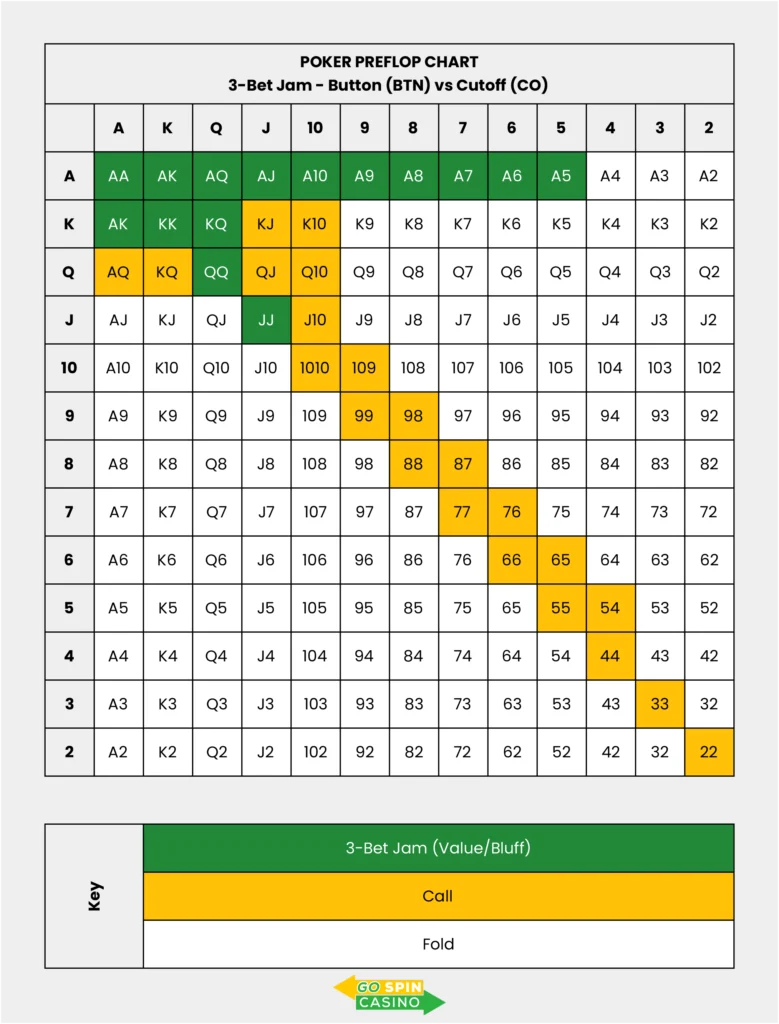
Key BTN vs CO 3-Bet Takeaways at 20BB:
- Jam value range: AA–JJ, AKs, AQs, AQo
- Bluff jam: A5s–A8s, KTs+, some suited blockers
- Flat: suited broadways, 22–99, suited connectors
- Fold offsuit combos or dominated hands
3-Bet Jam Chart – SB vs BTN – 20BB (6-Max)
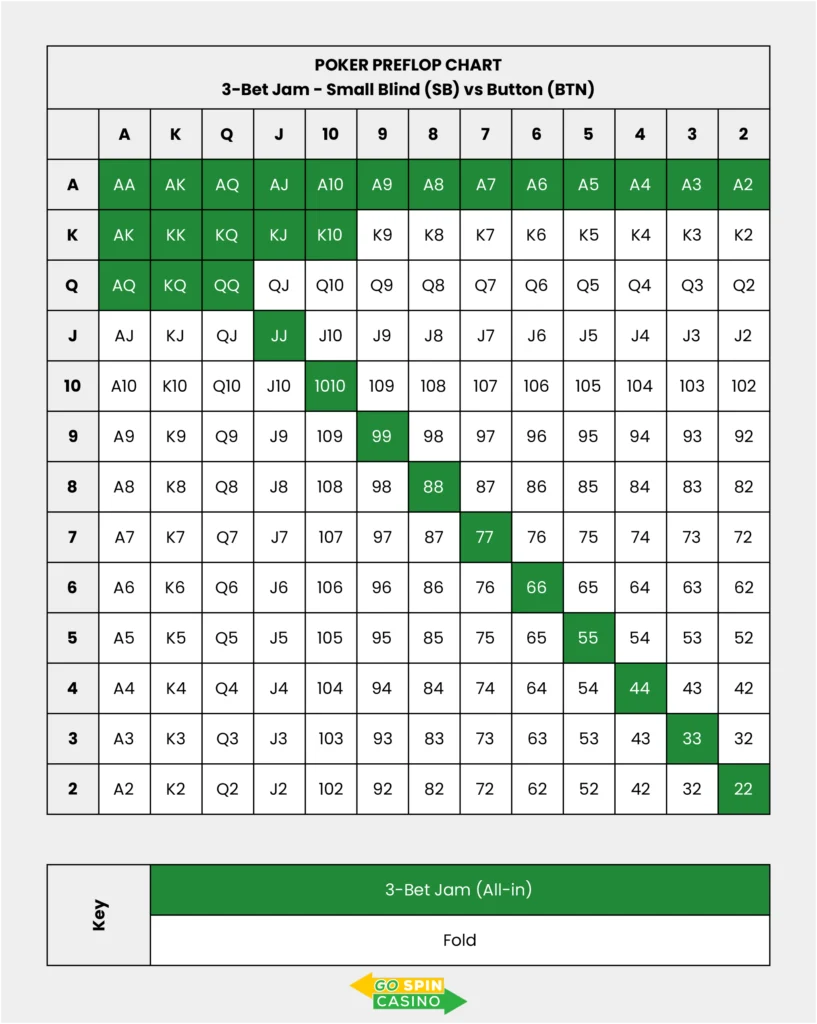
SB vs BTN at 20BB:
- Jam strong hands: All pairs, AK–ATs, KQs–KTs, A2s–A5s
- Bluff jams: wheel aces (A2s–A5s) for blocker value
- No flats: this spot is shove-or-fold only at 20BB
3-Bet Jam Chart – Big Blind (BB) vs Button (BTN) at 20BB effective (6-Max MTT)
From the BB, you’re closing action, so you can afford to flat more than in the SB. But you still need a sharp 3-bet jam range — especially vs aggressive BTN openers. The ideal jam hands here are:
- Value hands that don’t play well postflop
- Blockers and suited aces that prevent domination
- Broadways that fold out equity or deny realization
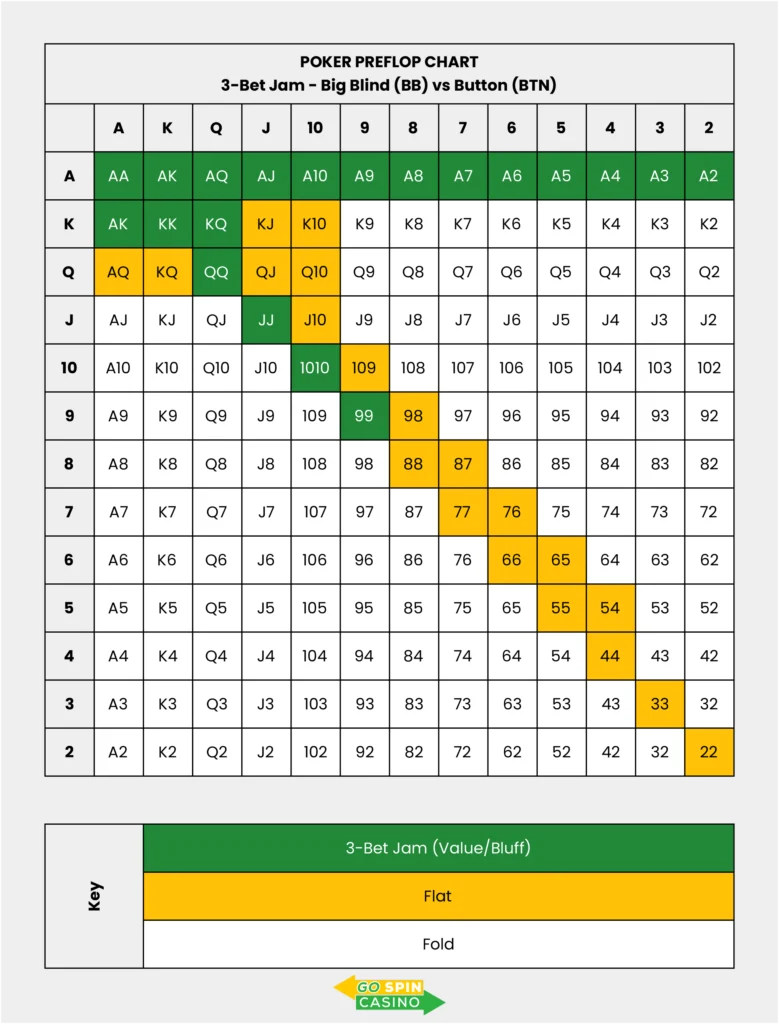
BB vs BTN at 20BB:
- Jam strong pairs, suited aces A2s–A9s, AK–AQ
- Flat medium pairs, suited broadways, suited connectors
- Fold dominated offsuit hands and weak suited trash
These charts aren’t training wheels, they’re your baseline for building poker instincts. And once you internalize them, you’ll start seeing the leaks in your opponents’ games before they even realize they’re making them.
Grab your free preflop charts now, and keep them within reach during your next session.
Because guessing is expensive. Planning isn’t.
How to Read a Poker Preflop Chart Like a Pro
You’ve downloaded the chart. Now what?
Reading a poker preflop chart isn’t rocket science, but if you don’t understand the logic behind it, you’ll misuse it or ignore it altogether. Once you learn how to interpret ranges based on position and hand class, it becomes automatic. You’ll recognize patterns, make confident decisions, and spend less time second-guessing mid-session.
Raise / Call / Fold Colors or Symbols Explained
Most preflop charts use intuitive color codes or symbols to make decision-making faster. Here’s how to read them:
- Green = Raise
Strong value hands and balanced bluffs. Standard open-raises from your position. - Yellow = Call
Hands that are profitable to flat, small pairs, suited aces, broadways with good blockers. - White = Fold
Hands that bleed chips long term. Don’t justify them with “let’s just see a flop.”
Pro tip: Don’t just memorize colors, understand the why. The chart reflects equity, playability, and positional leverage.
Using the Chart by Position
Let’s use the cutoff (CO), one of the most profitable spots to open wide.
Raise hands like:
- KQs, QJs, AJo, 99+, high-equity, value-rich
- 76s, A5s, KTo, hands that play well postflop and build fold equity
Fold hands like:
- ATo, KJo, QTo, reverse implied odds, often dominated
- J8o, 96o, unsuited gappers that look cute but cost you chips
Call hands like (facing a raise):
- 22–66 (deep stacks, in position)
- AJs, KQs vs. late-position opens
- A5s, 76s as occasional flats with a read or in soft lineups
Sticking to position-based ranges gives you consistency, even when you’re multi-tabling, short on sleep, or chasing a heater.
Adjusting On the Fly
Charts are your baseline, not gospel. The real edge comes from knowing when to deviate.
Facing a 3-bet?
- Tighten up, especially out of position
- Call with AK, QQ+, sometimes AJs or KQs vs. late-position 3-bets
- Fold marginal hands like KJo or ATo, even if they’re “green”
At a passive, loose table?
- Open wider: any suited ace, suited connectors, even Q9s from late position
- Value bet aggressively, these players call light and rarely push back
Short-stack opponents at the table?
- Prepare to call shoves more often: 66+, AJo+, KQs
- Don’t raise hands you’re not ready to call off, common leak in MTTs
Using a HUD?
- If someone’s VPIP > 40 and 3-bet% < 3%, steal wide and fold to aggression
- If they 3-bet 12%+, trap with premiums and flat suited aces
The better you get at adjusting to real-time variables, the more profitable your “off-chart” plays become. That’s when your strategy goes from memorized to mastered.
When to Raise, Fold or Call (Real Preflop Scenarios)
Charts are great, but poker’s played hand by hand. Understanding why you’re making a move is just as important as what the chart says to do. These are the high-frequency preflop spots where most players leak chips, not from bad luck, but from uncertainty.
Let’s fix that.
Raise First In (RFI) Scenarios
When you’re first to act and the pot is unopened, it’s your chance to take initiative. But the key isn’t just aggression, it’s disciplined aggression based on position.
Early Position (UTG – 6-Max)
Play tight and strong. Your range needs to respect the risk of being out of position post-flop.
- Open: 77+, AJs+, KQs, AQ+
- Avoid marginal offsuit broadways and small pairs here
Middle Position (HJ / CO)
Start widening your range. More fold equity, more postflop flexibility.
- Add hands like: A9s, KTs, QTs, 66+, JTs
- Suited connectors like 76s and 65s become profitable at soft tables
Button (BTN)
Your green light zone. Open wide, steal often, and pressure weak blinds.
- Any suited ace, suited kings, broadways, all pairs
- Hands like T9o or J8s are fully in range here
Want a deeper breakdown of the top-ranked starting hands? Here’s our hand ranking guide
Facing a Raise, Should You Call or 3-Bet?
Now you’re responding to an open. The decision tree depends on position, hand strength, and opponent type.
Flat (Call) With:
- Pocket pairs (22–99)
- Suited connectors (T9s, 98s)
- Suited broadways (KQs, AJs), especially in position
Be tighter if you’re out of position. Marginal hands become liabilities fast.
3-Bet for Value With:
- QQ+, AK, AQs+, hands that crush openers’ ranges
- Look for opportunities to isolate weaker players
3-Bet Bluff With:
- Blockers like A5s, KJo, Q9s
- Suited hands with equity that fold out better hands
- Works best against regs or loose openers who can fold
Rule of thumb:
If your hand’s too weak to call and not strong enough to 3-bet for value?
It’s either a bluff candidate, or a fold.
Need a refresher before diving deeper into ranges? Read our Poker Strategy for Beginners guide
Limp Pots, Exploitable or Dangerous?
Limpers are everywhere in low-to-mid stakes games. Some are traps. Most are just passives trying to see flops cheap.
Should You ISO-Raise?
Yes, if they’re folding to aggression often.
- Raise with value hands, suited aces, broadway-suited combos, and even hands like 98s, KTs
- Make it 4x–5x BB, not 2.5x, or they’ll peel with garbage
When to Check Behind:
- You have marginal equity, and stack sizes are shallow
- Hands like T8o or Q9s don’t want to build bloated pots
- Against tricky limp-raisers or deep-stacked splashers, pot control is key
The real leak in limp pots? Playing scared. If you’re folding too much or letting limpers dictate the pace, you’re ceding control, and your winrate.
Preflop mistakes are a fast track to tilt, here’s how to avoid it
These are the real-world preflop spots that separate breakeven grinders from actual winners. You don’t need to know every solver line, but you do need to know when to step on the gas and when to pump the brakes.
Get these spots right, and your winrate doesn’t just climb, it compounds.
Do You Really Need to Memorize Preflop Charts?
Let’s clear this up:
No, pro players aren’t memorizing every single preflop combo and GTO frequency.
That’s a myth, and honestly, one that trips up way too many smart players.
What top players actually rely on is pattern recognition. After thousands of hands, range study, and post-session reviews, they’ve internalized the right decisions by position and situation. They don’t need to pull up a chart mid-hand, they’ve already burned the structure into their instincts.
Trying to memorize full-range charts across every position, stack depth, and table type? You’re setting yourself up to freeze or overthink in real time.
Instead, focus on why certain hands make the cut. Ask:
- Why does AJo play poorly UTG but crush in late position?
- Why is 87s a great flat from the BTN but a fold in the SB?
That’s how you build true preflop intuition, the kind that holds up under pressure.
Start small.
Pick 2–3 positions, like Button, Cutoff, and Big Blind, and learn those ranges cold. That’s all you need to start building a serious edge.
You don’t have to master every spot overnight, you just have to play better than the guy still calling off KJo from UTG.
FAQ: Preflop Strategy Questions Players Actually Ask
Fold when your hand has poor equity and low playability from your position. That means folding offsuit broadways (like QTo) in early position, small unsuited aces (like A6o), and trashy gappers like J8o from anywhere but the button. If it’s close and you’re out of position, fold.
Almost never. The only real exception is in satellite or ICM-heavy situations where laddering up is worth more than chips (e.g., someone busting guarantees you a payout). Outside of that, get it in every time.
Start by finding your position at the table. Then locate your hole cards on the chart. Most use color coding or labels like Raise, Call, Fold. Green usually means raise, red means fold, blue for call. Some advanced charts include mixed strategies, but stick to clean, simple actions unless you’re deep into solver study.
It depends on position. From early position, raise strong ranges like 77+, AJs+, KQs. In late position (cutoff/button), you can raise suited connectors, suited aces, and any pair. For a full breakdown by position, check our Texas Hold’em starting hands ranked guide.
In 6-max cash games, aim for a VPIP of 18–25% and a PFR of 15–22%. If your VPIP is high but PFR is low, you’re calling too much and not applying pressure. A tight-aggressive profile, where you’re entering fewer pots but doing so with intent, is still the gold standard.
Rarely. Limping is passive and makes you easy to isolate. If you’re first in the pot, raise or fold. The only time limping makes sense is in multiway pots with deep stacks and speculative hands from late position, and even then, only at passive tables.
Target players who open too wide and fold to 3-bets often. Use blocker-heavy hands like A5s, KJo, or suited gappers with decent equity. Timing and position are everything, don’t bluff stations or short stacks unless you have a strong plan for the hand.
Final Take: Your Preflop Edge Starts with Structure, Not Luck
Poker isn’t a guessing game, or at least, it shouldn’t be. The players who consistently win aren’t lucky or psychic. They’ve just done the work before the cards hit the felt.
A solid preflop strategy means you’re not bleeding chips in marginal spots or hesitating when it’s time to apply pressure. It’s not about playing tight, it’s about playing with purpose. And that purpose starts with structure.
Preflop charts aren’t a crutch. They’re a framework. A way to train your instincts, eliminate second-guessing, and stay sharp under pressure. Start by mastering a few positions. Understand why certain hands play better from certain spots. Then learn to adapt, because poker isn’t static, and neither are your opponents.
At the end of the day, your edge isn’t in the cards, it’s in the decisions.
And most of those decisions happen before the flop.
